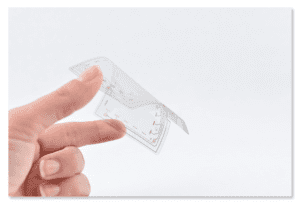There are two main material substrates that can be used to make flexible circuits. The first is commonly referred to as Kapton – DuPont’s trade name for polyimide film. Because polyimide/Kapton can withstand very high temperatures, post processing of etched copper circuitry is possible. The second substrate is polyester film printed with silver conductive ink. Polyester is a very robust polymer, but not as heat resistant as Kapton. However polyester has other excellent properties that make it outstanding for many flexible circuits.

Kapton can be thought of more like a printed circuit board (PCB) with very thin/flexible (.005” thick material). The conductive traces are copper just like a PCB and processed similarly. Many companies offer and design Kapton circuits as an option, however most companies do not process it in-house. Kapton circuits require a special chemical processing, similar to PCB boards – it is a subtractive process (chemical intensive, not eco-friendly), in comparison silver printing is an additive process and better for the environment.
Both Kapton/copper and polyester/printed silver can be covered with a dielectric cover layer for protection of the circuit traces from oxidation, abrasion, or electrical shorts. While the two materials do have their similarities, they also have their differences; Kapton offers some advantages over printed silver circuits:
- Kapton is the base circuit material and offers good insulation properties and heat resistance
- Copper trace widths can be very narrow while the electrical resistance remains For instance, with printed silver, a typical switch resistance spec is 100 ohms max, while these same traces might be less than 10 ohms for Kapton/copper circuits. This means that a copper circuit can conduct the same electricity in a narrower trace width than silver can.
- The copper can be gold plated (and typically is), this provides low contact resistance for metal domes during life cycling
- Any components, LED’s, resistors, capacitors, integrated circuit (IC) chips, etc. can be soldered on Kapton/copper circuits. This is where Kapton really performs like a traditional printed circuit board – the high temperature resistance of the film allows the high temperatures of reflow soldering without damage. Electrical circuit functionality is greatly increased using Kapton (consider it equal to a PCB board but more flexible.) This cannot easily be done with silver circuits because the polyester film cannot tolerate the time and heat requirements of soldering. As a result component attachment processes such as conductive epoxy and encapsulation can be used to mount certain components to polyester.
- It is possible to etch much narrower trace widths/spaces with Kapton/copper than it is to screen print on silver circuits – although the gap is closing – Kapton with gold plating circuit tails can be made to fit ZIF connectors down to 0.2mm trace pitch traces while printed silver is just now approaching applications for ZIF connectors down to 0.5mm trace pitch. At 0.5mm trace pitch it is challenging to screen print carbon over the silver at the tail ends for protection.
So why would anyone make a flexible circuit on something other than Kapton with copper traces? Simple – it comes down to cost and flexible manufacturing! Kapton comes at a premium price – perhaps 2x the cost of polyester, and the copper etching / stripping process is a more capital intensive process than screen printing. Because screen printing is a more user friendly additive process, it can be used to print incredible silver circuits for membrane switches and many other printed electronic applications.
Want more information? We’re happy to answer any questions!
